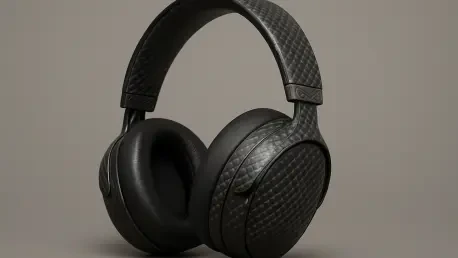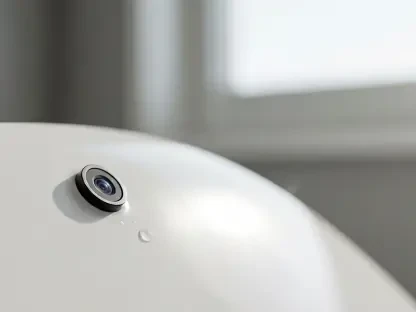In an era where audio technology is constantly pushed to new heights, a staggering statistic reveals that over 60% of audiophiles still crave a listening experience that transcends the convenience of wireless devices. Enter a groundbreaking innovation from German audio specialist HEDD—a headphone that promises to redefine sound quality with a world-first material. This review delves into the HEDD D1, the first dynamic, open-back consumer headphone to feature a Thin-Ply Carbon Diaphragm (TPCD), exploring how this cutting-edge technology could reshape the expectations of high-fidelity audio enthusiasts.
Unveiling the HEDD D1 and Thin-Ply Carbon Technology
The HEDD D1 emerges as a bold statement in the audiophile market, where the demand for pristine sound reproduction continues to grow. At the heart of this headphone lies the revolutionary TPCD, a material renowned for its exceptional stiffness-to-density ratio and low mass. Originally utilized in high-stakes industries like aerospace and motorsport, this advanced composite has been adapted for audio use, promising a level of clarity and precision previously unattainable in consumer headphones.
This adaptation marks a significant shift in how audio equipment can leverage materials science. The collaboration between HEDD and Composite Sound of Sweden has resulted in a diaphragm that excels in delivering rapid transients and minimizing distortion. With a development process spanning several years starting from 2025, this technology showcases a commitment to pushing boundaries, catering to listeners who prioritize sound purity over modern conveniences.
Breaking Down the Standout Features
The Power of the Thin-Ply Carbon Diaphragm
Central to the HEDD D1’s allure is the TPCD, a material that combines resilience with lightweight properties to create an unparalleled listening experience. Its ability to respond swiftly to audio signals ensures that even the most subtle nuances in music are captured with stunning accuracy. This diaphragm’s design draws inspiration from applications in extreme environments, such as components in space exploration and high-speed racing, highlighting its robustness and adaptability for audio excellence.
Unlike traditional diaphragm materials, the TPCD offers a unique balance of rigidity and minimal weight, reducing unwanted vibrations that often muddy sound output. This results in a cleaner, more detailed audio profile that audiophiles are likely to appreciate during extended listening sessions. The meticulous engineering behind this component sets a new benchmark for what dynamic drivers can achieve in consumer-grade equipment.
Open-Back Design for Superior Soundstaging
The HEDD D1 embraces an open-back, wired configuration, a deliberate choice that prioritizes immersive sound over portability features like Bluetooth connectivity. This design allows for a wider soundstage, creating a sense of spatial depth that makes listeners feel as though they are in the midst of a live performance. Such an approach is ideal for critical listening environments where every detail matters.
By forgoing active noise cancellation, the headphone focuses on delivering unadulterated audio, free from electronic interference. This caters directly to a niche audience that values transparency and realism in their music, often in controlled settings like home studios or dedicated listening rooms. The open-back structure enhances airflow around the drivers, further contributing to a natural and expansive sound profile.
Pushing Audio Innovation Forward
The adoption of advanced materials like Thin-Ply Carbon in audio devices signals a broader trend within the industry toward redefining performance standards. As manufacturers explore alternatives to conventional components, the emphasis on dynamic driver innovation becomes increasingly evident. The HEDD D1 stands at the forefront of this movement, demonstrating how cross-industry technologies can elevate consumer experiences.
Beyond just material advancements, this trend reflects a growing curiosity about how engineering precision can translate into tangible audio benefits. The integration of such high-performance elements suggests a future where headphones are not merely accessories but precision instruments. This shift could inspire other brands to experiment with novel materials, potentially transforming the landscape of high-end audio gear.
Targeting the Audiophile Niche
Designed with serious audio enthusiasts in mind, the HEDD D1 finds its true home in stationary listening setups rather than on-the-go scenarios. Its wired nature and open-back design make it less suited for noisy environments or casual use, instead excelling in spaces where external distractions are minimal. This focus aligns with the preferences of a dedicated audience seeking uncompromising sound quality.
In contrast to the broader market’s inclination toward wireless and noise-canceling options, this headphone carves out a distinct space for itself. Its appeal lies in the meticulous reproduction of audio details, catering to those who invest in high-resolution music sources and specialized amplifiers. This niche positioning underscores a commitment to a traditional yet highly valued listening ethos.
Navigating Challenges and Market Realities
Despite its innovative edge, the HEDD D1 faces hurdles that could temper its widespread adoption. Priced at $799, it sits in a premium bracket that may deter casual consumers, especially when compared to competitors offering wireless features and active noise cancellation at similar or lower costs. This price point, while competitive within the audiophile wired segment, limits its reach to a specialized clientele.
Additionally, the lack of modern conveniences like Bluetooth may be seen as a drawback in a market increasingly driven by versatility. However, HEDD counters these concerns with a strong emphasis on sustainability, ensuring all components are serviceable, and backing the product with a robust five-year warranty. Such measures aim to justify the investment by promising durability and long-term value.
Envisioning the Future of Audio Materials
Looking ahead, the introduction of Thin-Ply Carbon in headphones like the HEDD D1 hints at exciting possibilities for audio technology. As this material gains traction, it could pave the way for even lighter and more responsive drivers, further refining sound reproduction. The potential for broader adoption across different product categories, from earbuds to professional studio monitors, remains a compelling prospect.
Moreover, the success of such innovations may encourage research into other advanced composites or hybrid materials tailored for audio applications. If current trends persist, consumer expectations for durability and performance in audio equipment are likely to rise, challenging manufacturers to balance cost with cutting-edge design. This evolution could redefine benchmarks for quality in the years beyond 2025.
Reflecting on a Pioneering Step in Audio
Looking back, the HEDD D1 carved a notable path in the audio landscape with its groundbreaking Thin-Ply Carbon Diaphragm, setting itself apart in a competitive field of high-end headphones. Its focus on audiophile-grade sound through an open-back, wired design resonated with a dedicated audience, even as it navigated challenges like premium pricing and limited mainstream appeal. The industry took notice of how material innovation could elevate listening experiences.
For those intrigued by this advancement, the next step involved seeking out hands-on experiences to validate the bold claims surrounding the TPCD technology. Manufacturers and enthusiasts alike were encouraged to explore how such materials could be integrated into diverse audio products, potentially sparking a wave of experimentation. The journey of audio tech promised to be an exciting one, with the HEDD D1 having laid a solid foundation for future explorations in sound fidelity.









